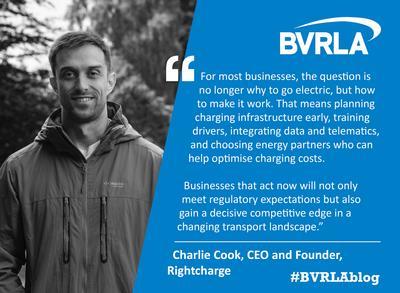Charlie Cook, CEO and Founder of associate member Rightcharge explores how fleet electrification has moved from future ambition to everyday reality. With businesses now driving the majority of new EV registrations, Charlie examines the policies, costs and climate factors shaping the shift - and how fleets can make the transition work in practice.

Fleet electrification isn’t a distant ambition anymore - it’s a reality unfolding on Britain’s roads today. Across the UK, businesses are leading the charge, with fleets now accounting for more than 60% of new electric vehicles (EVs) registered. The momentum is clear: electric vehicles are proving good for the bottom line, good for compliance, and good for carbon.
Policy is Sealing the Deal
The UK’s policy direction is firmly set. With the Zero Emission Vehicle (ZEV) Mandate now in law, manufacturers are required to ensure that 80% of new cars and 70% of new vans sold by 2030 are zero-emission. This regulation cements the government’s long-term commitment to cleaner transport and provides the market with the certainty it needs to invest.
Financial support for electrification remains generous. Businesses can still take advantage of initiatives such as the Workplace Charging Scheme, Electric Car Grant, Plug-in Van Grants, and Benefit-in-Kind (BiK) tax incentives, along with favourable capital allowances. Far from being peripheral benefits, these measures form a core part of the business case for going electric.
The Money Case
While the upfront purchase or lease price of an EV continues to attract attention, it’s the running costs that truly distinguish electric fleets. When vehicles are charged primarily at home or at depot-based chargers, the cost per mile can fall to as little as 1.7p, especially on specialist EV tariffs.
Over a typical four-year lease cycle, the total cost of ownership often achieves parity - and in many cases, an advantage - over internal combustion engine vehicles. Lower fuel and maintenance costs, exemptions from ULEZ and other clean air charges, and the absence of consumables like oil or clutch components all contribute to savings.
For fleet operators managing large or mixed vehicle groups, these efficiencies scale rapidly. EVs also bring operational simplicity: fewer moving parts, longer service intervals, and smoother performance for drivers. In short, they make business sense as much as environmental sense.
The Climate Case
Electrification remains one of the most effective routes to decarbonising road transport. Every EV on the road eliminates tailpipe emissions - a major source of Scope 1 emissions for many organisations. But the sustainability benefits don’t stop there.
As the UK’s electricity grid becomes cleaner, the carbon footprint of each electric mile shrinks further. When combined with smart charging strategies - for example, charging overnight during renewable-rich, off-peak hours - emissions linked to vehicle charging can be cut by up to 30%.
Making the Final Mile Count
For most businesses, the question is no longer why to go electric, but how to make it work. That means planning charging infrastructure early, training drivers, integrating data and telematics, and choosing energy partners who can help optimise charging costs.
Our latest report, The Business Case for EVs, dives deeper into these opportunities, outlining practical steps for fleets ready to accelerate their transition. From cost models and grant summaries to carbon-saving projections, it’s a valuable resource for decision-makers at every stage of their electrification journey.
The road ahead is clear: electrification is not just the future of fleet - it’s the present. Businesses that act now will not only meet regulatory expectations but also gain a decisive competitive edge in a changing transport landscape.
Read the Rightcharge report in full: The Business Case for EVs.



